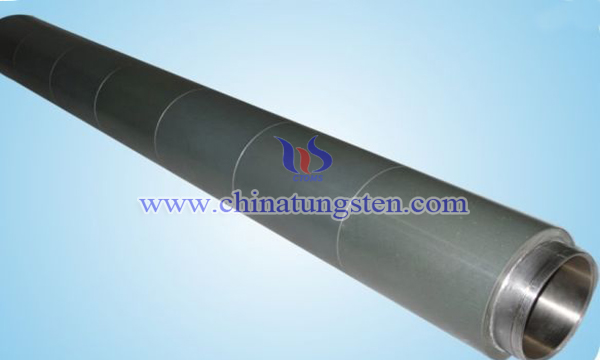Production Method of Rotary Target Using Tungsten-Molybdenum Alloy
- Details
- Category: Tungsten Information
- Published on Wednesday, 25 July 2018 18:49
Thin-film-transistor (TFT) film has the advantages of high responsivity, high brightness and high contrast. It is one of the basic materials in many industries. Therefore, it is widely used in the fields of solar cells, liquid crystal displays and plasma displays. In recent years, along with the rapid development of high-end displays, tungsten Molybdenum alloy rotary targets have become an important material for the preparation of TFT films.

The core technical difficulty of the TFT rotary target is to control the cracking and low density problems in the molding process, and the uniformity control of the shrinking target of it during the sintering process. In order to solve these technical problems, researchers in China have developed a production method of the rotary target using tungsten-molybdenum alloy. This method has a simple process, which not only greatly reduces the production cost, but also has the excellent properties of fine uniform grain size and high thermal shock resistance. It is also suitable for large-area production.
The production method is as following steps:
Step 1: Select tungsten powder with a theoretical density of 98% or more, an average Fisherman's particle size of 3 to 7 μm, and a molybdenum powder with a theoretical density of 98% or more and an average Fischer particle size of 1 to 10 μm, and follow (3~5): The mass ratio of (7~5) is put into the double-stack mixer, and the mixture is fully mixed under the condition of the speed of 50r/min~80r/min.
Step 2: arbitrarily select five points in the material after the step 1 to detect the tungsten content and the molybdenum content until the tungsten-molybdenum content ratio error of each detection point is between 0.01 and 0.05%. The mixing is completed;
Step 3, the mixture after the 2nd step is mixed through a 200 mesh sieve, and used;
Step 4: The mixture material processed in the third step is filled into a rubber sleeve containing a tubular flexible mold, and molybdenum disulfide powder is applied on the contact surface of the mold and the mixture material, and then the rubber sleeve is sealed, vacuumed, and vacuumed. The rubber sleeve is placed on a cold isostatic press, and the initial pre-compression is carried out under the condition of pressure of 20-50 MPa to form a rough blank, and the obtained rough embryo is subjected to secondary pressing under the condition of 50-200 MPa until the raw The density of the billet reaches 60~62% of the theoretical density, and the pressure is released to normal pressure for use;
Step 5: place the tungsten-molybdenum alloy target raw embryo in step 4 in a vacuum hot-pressing sintering furnace, and performing hot-press sintering under a hydrogen atmosphere, a pressure of 20-30 MPa, and a temperature of 1000-1350 °C. After 3~5h of heat preservation, the mold is demolded at 400~1000°C by high temperature demoulding process, cooled to room temperature, and the crude tungsten-molybdenum alloy target is prepared and used.
Step 6. The crude tungsten-molybdenum alloy target obtained in step 5 is machined to the required size, and then placed in a vacuum annealing furnace, and heated to 1000~1600 ° C for 1~2 h for standby;
Step 7. Perform chemical and physical testing on the crude tungsten-molybdenum alloy target processed in step six, and then ultrasonically clean the target to achieve acceptable roughness and reserve;
Step 8. Take the mixture material after the third step, and put the mixture into a ball mill for 2~3h, and pass through 800~1000 mesh to obtain the tungsten-molybdenum spray powder, and set aside;
Step 9. The tungsten-molybdenum powder prepared in step 8 to the outer surface of step 7 by plasma spraying in an inert gas atmosphere to be used;
Step 10. The target cavity prepared in the step 9 is subjected to vacuum treatment, and then an inert gas is introduced therein, the gas flow rate is 500-1000 SCCH, and the tungsten-molybdenum obtained in the step 8 is sprayed under an inert gas atmosphere. The powder is cold sprayed into the cavity of the target, and the thickness of the spray is 0.1~0.2mm to obtain the product.
The rotary target prepared by the method can rotate the target around the fixed strip magnet assembly during the sputtering process, so that 360° can be uniformly etched, and the sputtering atom can fly in all directions, and the uniformity is excellent. The sputtering area is large, the replacement operation is convenient, the production efficiency is high, the target utilization rate is high, and the deposition on the inner wall of the part has unique advantages.
- Tungsten Alloy Manufacturer & Supplier, Chinatungsten Online: www.tungsten-alloy.com
- Tungsten News & Prices of China Tungsten Industry Association: www.ctia.com.cn
- Molybdenum News & Price: news.molybdenum.com.cn
- Tel.: 86 592 5129696; Fax: 86 592 5129797; Email: sales@chinatungsten.com



 sales@chinatungsten.com
sales@chinatungsten.com